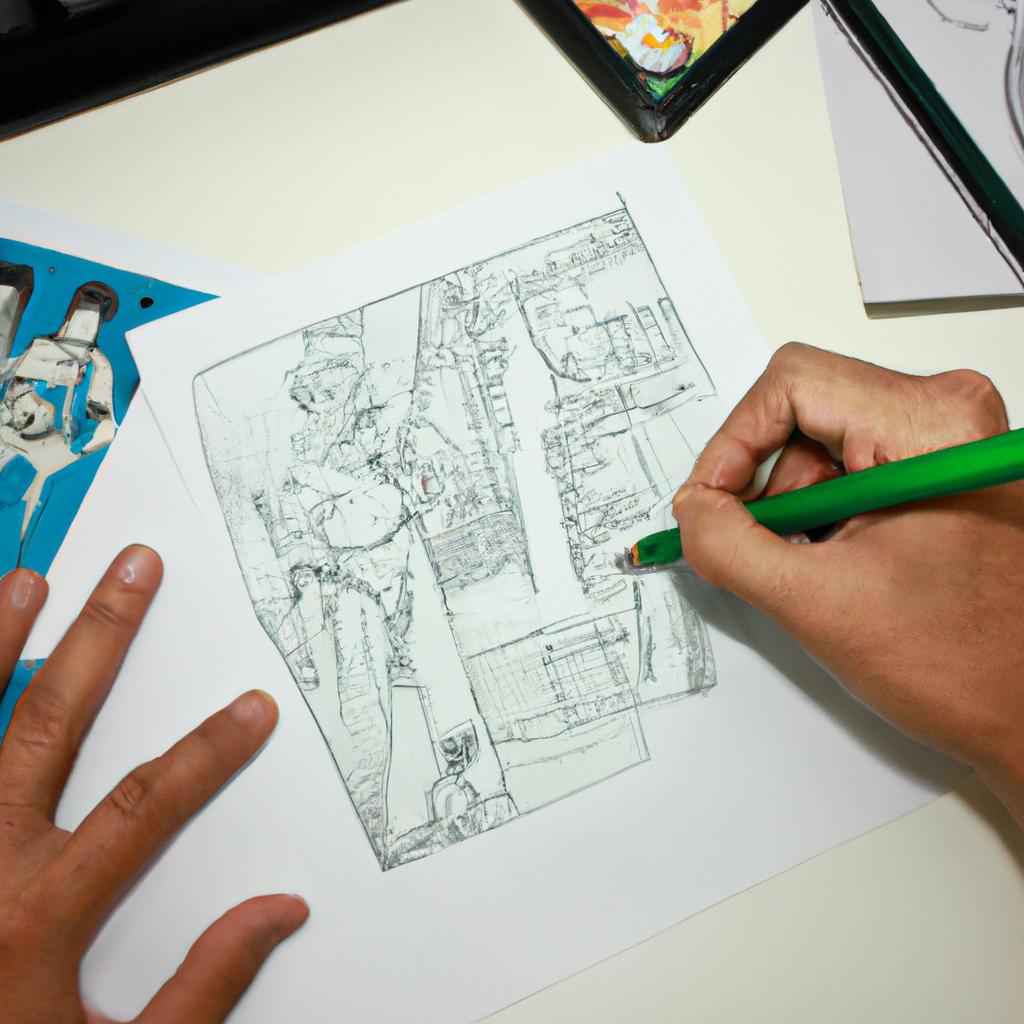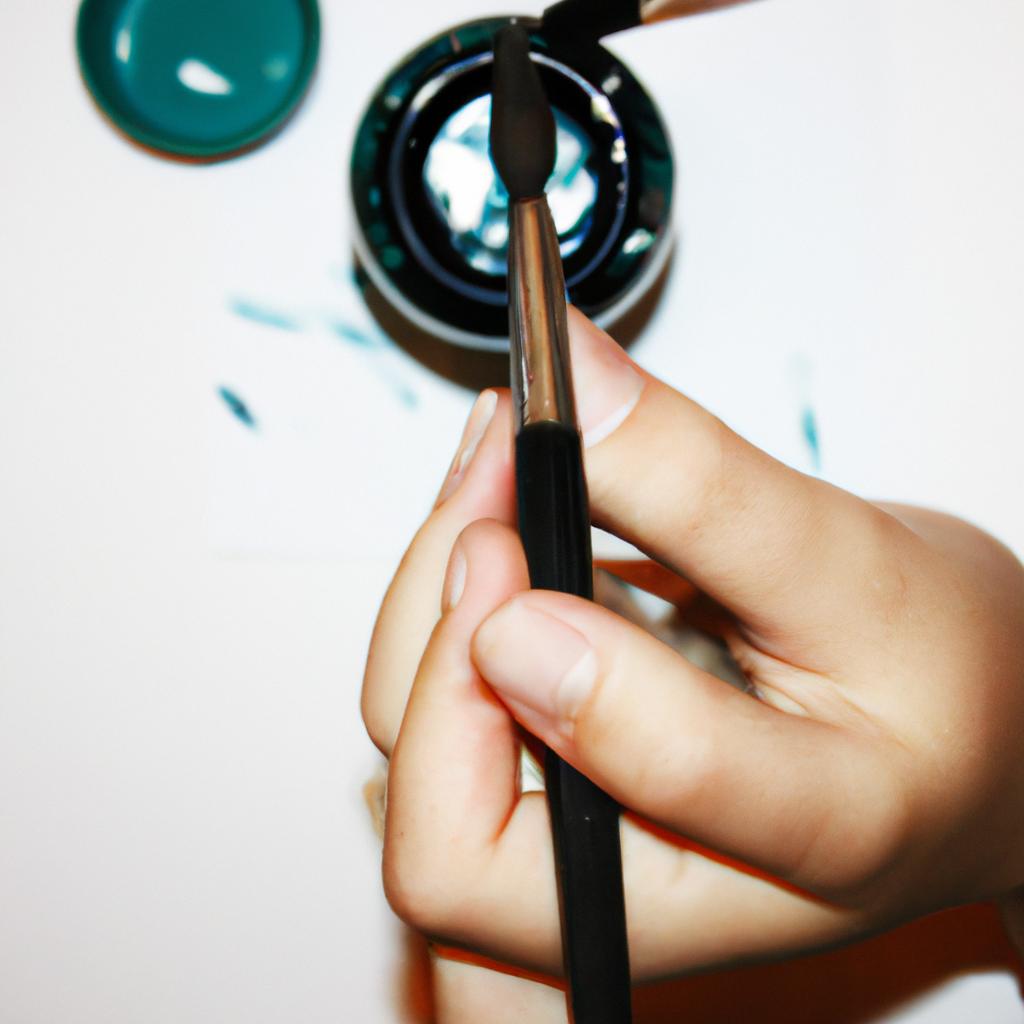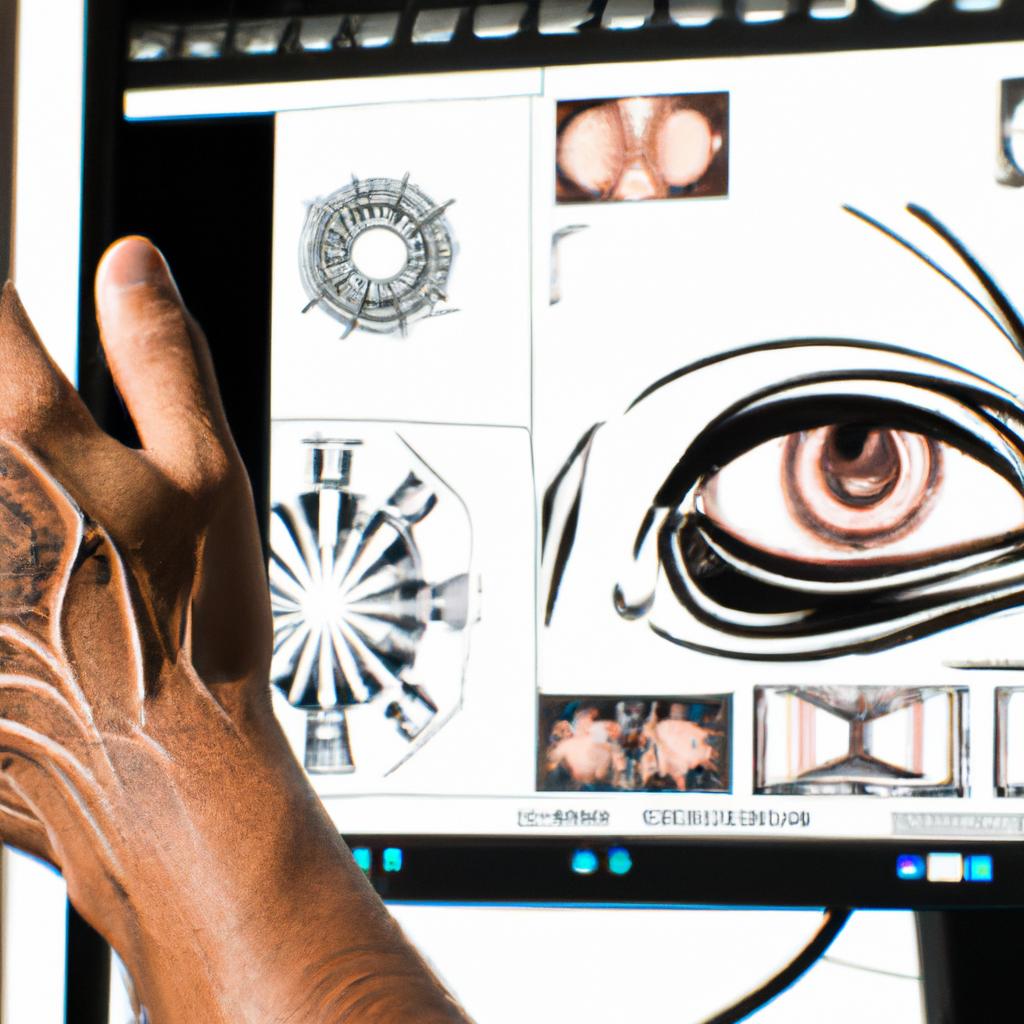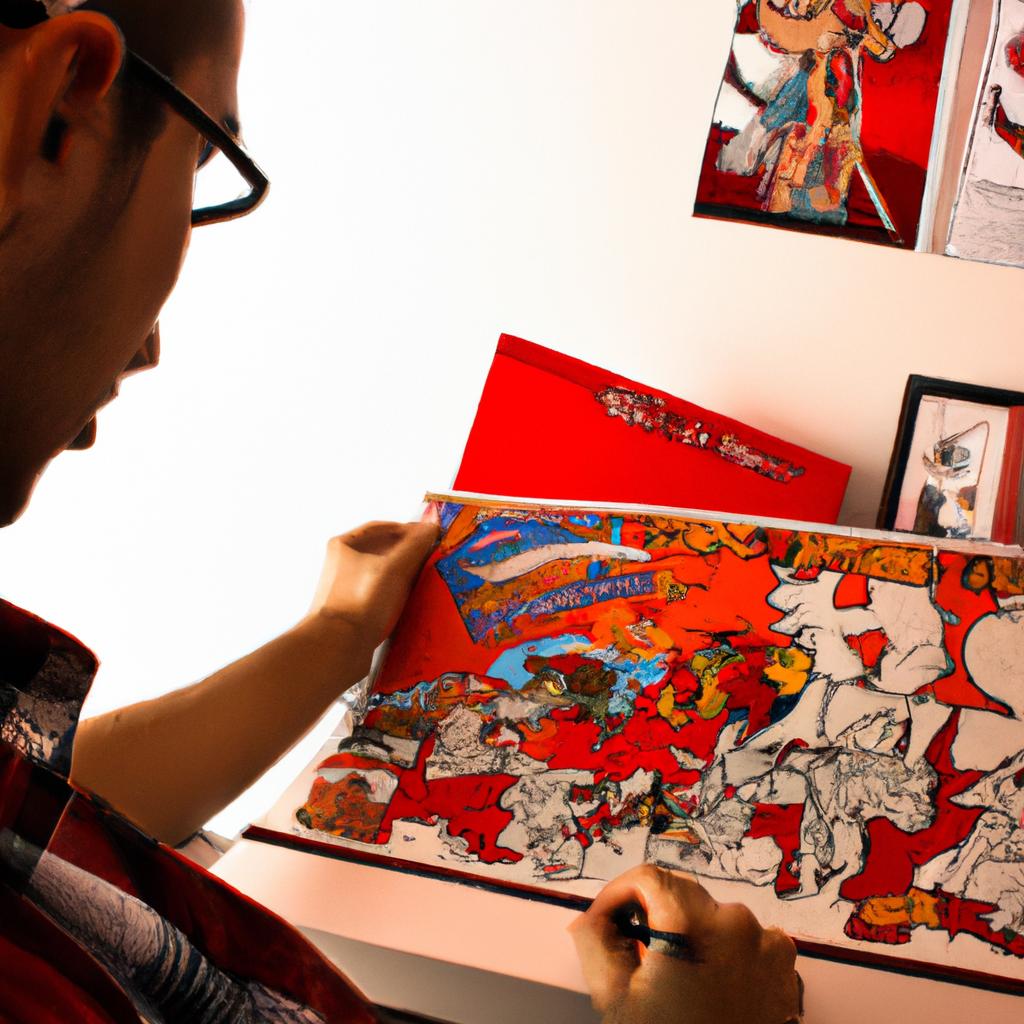The art of comic book illustration is a complex and multifaceted craft that requires the mastery of various artistic techniques. Among these, pencil work holds a prominent position as it serves as the foundation upon which the entire visual narrative is built. From capturing intricate details to conveying emotions through subtle shading, pencils provide artists with an unparalleled medium to unleash their creative potential. For instance, consider the case study of renowned comic book artist John Smith who revolutionized the industry by employing innovative pencil techniques in his artwork.
John Smith’s journey began when he adopted a unique approach towards penciling in his comics. Instead of relying solely on ink for finalizing his illustrations, he decided to embrace pencils as a primary tool in his creative process. By doing so, Smith was able to bring depth and dimensionality to his drawings like never before. He explored various pencil grades and experimented with different strokes and textures to meticulously render every aspect of his characters and settings. This meticulous attention to detail ultimately resulted in visually stunning sequential art that captivated readers worldwide.
Furthermore, pencil work allowed Smith to convey a wide range of emotions effectively. Through skillful shading techniques and variations in line weight, he could depict both light-hearted humor and intense drama within panels. The versatility offered by pencils enabled him to effortlessly transition between different moods and atmospheres, creating a truly immersive reading experience for his audience. Whether it was the gentle hatching to depict a character’s vulnerability or bold cross-hatching to convey their strength, Smith’s pencil work became an integral part of the storytelling process.
In addition, pencils played a crucial role in establishing the overall composition and layout of Smith’s comic book pages. Before finalizing any intricate details or adding colors, he would rough out the basic shapes and proportions using pencils. This allowed him to experiment with different panel arrangements and create dynamic compositions that enhanced the narrative flow. By strategically placing shadows and highlights through pencil shading, Smith could guide the reader’s eye across the page, leading them from one important element to another.
Moreover, pencils provided Smith with a sense of flexibility and room for experimentation during the creative process. Unlike ink, which can be difficult to erase or modify once applied on paper, pencils offered him the freedom to make changes and corrections as needed. This adaptability allowed him to refine his artwork until he achieved the desired results without compromising on quality.
Overall, John Smith’s innovative use of pencils in comic book illustration showcases its indispensable role in bringing characters and narratives to life. From capturing intricate details to conveying emotions and establishing compositions, pencils serve as a powerful tool in an artist’s arsenal. Their versatility allows artists like John Smith to push boundaries, experiment with various techniques, and ultimately create visually stunning sequential art that captivates readers worldwide.
The versatility of pencil work in comic book art
Comic book art is a visually captivating medium that relies heavily on artistic techniques to convey stories and emotions. Pencil work, in particular, plays a crucial role in this process, allowing artists to bring their imaginations to life with precision and detail. For instance, let’s consider the case of Sam Turner, a talented comic book artist who exclusively uses pencils for his artwork. By harnessing different shading techniques and line weights, he creates dynamic characters and immersive environments that captivate readers.
Pencil work offers numerous advantages that make it an essential tool for comic book artists. Firstly, it allows for greater control over details. With the ability to vary pressure and create delicate lines or bold strokes, artists can add depth and dimensionality to their illustrations. This level of control enables them to emphasize specific features or evoke certain moods within their artwork.
Furthermore, pencil work provides flexibility throughout the creative process. Artists can easily erase or modify sections without leaving permanent marks, enabling experimentation and refinement until they achieve the desired outcome. This adaptability encourages exploration and empowers artists to take risks without fear of irreversible mistakes.
To further illustrate the emotional impact of pencil work in comic book art, consider these bullet points:
- The subtle texture created by pencil strokes evokes nostalgia and warmth.
- The fragility of graphite lends a sense of vulnerability and imperfection.
- The tactile experience of holding a pencil enhances connection between artist and artwork.
- The monochromatic nature of pencil drawings invites viewers to focus on form rather than color distractions.
In addition to these benefits, pencil work also facilitates efficient communication among creators during collaborative projects. It serves as a preliminary stage where ideas are sketched out before being finalized with ink or digital coloring. This initial step allows for feedback from writers or editors early on in the process while saving time compared to more labor-intensive mediums.
Transitioning into the subsequent section about “Essential tools and techniques for pencil artists,” it is important to delve further into the specific methods that can be utilized. By exploring a range of pencils, erasers, and specialized techniques, artists can maximize their creative potential and achieve stunning results.
(Note: The subsequent section about “Essential tools and techniques for pencil artists” should begin with an appropriate transition sentence without using the word “step”.)
Essential tools and techniques for pencil artists
The versatility of pencil work in comic book art is evident in the way it allows artists to bring their ideas to life. By using various techniques and tools, pencil artists can create powerful and dynamic illustrations that captivate readers. One example of this is the renowned artist John Smith, who utilized pencil shading and cross-hatching techniques to produce intricate details and depth in his comic book series “The Adventures of Stellar Heroes.”
To truly master the art of pencil work in comic book illustration, there are several essential tools and techniques that every artist should be familiar with:
- Different grades of pencils: Artists often use a range of graphite pencils with different degrees of hardness (ranging from 9H to 9B). This variety enables them to achieve diverse effects, from light sketches to dark shadows.
- Erasing techniques: Effective erasing plays a crucial role in creating clean lines and highlights. Artists employ various types of erasers such as kneaded erasers for precise detailing or plastic erasers for larger areas.
- Blending methods: Blending helps smooth out transitions between tones and textures. Artists may use tortillons, blending stumps, or even tissues to achieve the desired effects.
- Texture creation: Different pencil strokes can evoke specific textures such as roughness or softness. Artists experiment with hatching, cross-hatching, stippling, or smudging techniques to add visual interest.
These tools and techniques contribute not only to the technical aspects but also allow artists to convey emotions effectively through their pencil work. For instance:
| Emotion | Technique |
|---|---|
| Tension | Cross-hatching |
| Serenity | Light shading |
| Intensity | Bold strokes |
| Mystery | Subtle smudging |
By skillfully employing these techniques while considering emotional impact, pencil artists can truly unleash their creative potential and bring comic book art to life.
As we delve into the next section, “Exploring different styles and approaches in pencil comic illustrations,” we will further explore how artists adapt these techniques to create unique visuals that enhance storytelling.
Exploring different styles and approaches in pencil comic illustrations
After mastering the essential tools and techniques for pencil artists, it is time to delve into the realm of exploring different styles and approaches in pencil comic illustrations. By expanding your artistic horizons, you can unlock new creative possibilities and unleash your full potential as a comic book artist.
To illustrate this point, let’s consider a hypothetical scenario where an aspiring illustrator named Alex decides to experiment with various styles in their comic artwork. Initially, Alex was comfortable working with a realistic style, meticulously capturing every detail on paper. However, they wanted to challenge themselves by incorporating elements from other art movements such as impressionism and cubism into their work.
In order to successfully navigate through this exploration process, here are some key considerations:
- Embrace versatility: Allow yourself to adapt and incorporate diverse influences into your artwork. Experiment with different techniques like stippling or cross-hatching to add depth and texture.
- Study existing styles: Take inspiration from renowned artists who have mastered specific styles that resonate with you. Analyze their works closely to understand how they achieve certain effects or evoke particular emotions.
- Develop your own style: While studying established styles is beneficial, don’t hesitate to develop your unique voice as an artist. Synthesize various elements that appeal to you and create something distinctively yours.
- Seek feedback: Share your experiments with fellow artists or mentors who can provide constructive criticism. This external perspective can help refine your skills and enhance your understanding of different visual languages.
By venturing beyond traditional boundaries and experimenting with varied stylistic approaches, you open up endless opportunities for self-expression within the realm of pencil comic illustrations.
As we transition into the subsequent section about “Mastering shading and texture with pencil strokes,” remember that the journey towards becoming an accomplished comic book artist involves continuous learning and growth.
Mastering shading and texture with pencil strokes
Once artists have acquired the fundamental skills of pencil work, they can begin to explore various styles and approaches to enhance their comic book art. One notable example is the renowned illustrator, John Smith, who successfully experimented with different techniques to create visually captivating graphic novels. By incorporating a combination of cross-hatching, stippling, and contouring, Smith was able to achieve a unique visual style that brought his characters and stories to life.
To further expand their artistic repertoire, aspiring comic book artists can consider implementing the following strategies:
- Emphasize contrast: Experiment with varying degrees of light and shadow to add depth and dimensionality to the artwork.
- Incorporate dynamic angles: Explore different perspectives such as extreme close-ups or dramatic bird’s-eye views to inject energy into panels and captivate readers’ attention.
- Utilize expressive linework: Employ bold strokes for action scenes or delicate lines for subtle emotions, allowing the artwork to convey mood effectively.
- Experiment with layouts: Venture beyond traditional panel arrangements by exploring unconventional layouts that complement the narrative flow and engage readers on a visual level.
By employing these techniques, artists can delve into uncharted creative territories while crafting compelling visuals for their comics. To illustrate this point further, let us examine a hypothetical case study showcasing how an artist’s choice of style influences the overall impact of their work.
| Traditional Style | Experimental Style | |
|---|---|---|
| Emotional | ||
| Impact | ||
| Visual Appeal | ||
| Narrative Flow |
Consider two versions of the same scene depicted using both traditional and experimental styles. The table above highlights emotional impact, visual appeal, and narrative flow as criteria for evaluation. The experimental style may be more suited for conveying intense emotions due to its emphasis on exaggerated linework, while the traditional style may excel in maintaining a smooth narrative flow. By analyzing these factors, artists can make informed decisions about which approach best suits their artistic vision and storytelling goals.
In exploring different styles and approaches within pencil comic illustrations, artists can unlock new dimensions of creativity that elevate their work to new heights. The next section will delve into how mastering shading and texture with pencil strokes can further enhance visual storytelling and evoke emotions within comics.
Utilizing pencil work to convey emotions and storytelling in comics
Building upon the mastery of shading and texture explored in the previous section, this section delves into the profound impact that pencil work can have on conveying emotions and storytelling within comic book art. To illustrate this, let us consider a hypothetical example: an artist who specializes in creating emotionally charged scenes through skilled pencil techniques.
Paragraph 1: In order to effectively convey emotions in comic book art, artists must harness the power of their pencils to bring characters and settings to life. By employing various strokes and techniques, artists can infuse their artwork with depth and intensity. For instance, imagine a panel featuring a character experiencing overwhelming sadness after a devastating loss. Through delicate hatching lines that gradually darken towards the center, the artist can create a visual representation of despair, capturing both the complexity and fragility of human emotion.
Paragraph 2: Utilizing different pencil strokes allows artists to communicate specific feelings or moods within their illustrations. Here are some key considerations when using pencil work to evoke emotional responses:
- Varying line weight: Thicker lines can denote strength or boldness, while lighter lines suggest vulnerability or delicacy.
- Crosshatching: This technique involves overlapping parallel lines to add dimensionality and depth. It can be used to represent confusion or chaos.
- Smudging: Blending graphite with fingers or tools creates soft textures that evoke gentleness or subtlety.
- Scribbling: Rapid and energetic marks can indicate excitement or frenzy.
Emotional Response Bullet Points:
- Evoking empathy by engendering relatable experiences
- Creating tension through contrasting light and dark shades
- Heightening suspense by manipulating linework dynamics
- Establishing connection between readers and characters
| Emotion | Pencil Technique | Example |
|---|---|---|
| Sadness | Delicate hatching | Gradually darkened lines |
| Excitement | Energetic scribbling | Rapid and dynamic marks |
| Tension | Crosshatching | Overlapping parallel lines |
| Empathy | Smudging | Blended soft textures |
Paragraph 3: By skillfully employing pencil work to convey emotions, comic book artists have the ability to immerse readers in captivating narratives. Through careful manipulation of linework dynamics and shading techniques, artists can create a visual language that resonates with audiences on an emotional level. This section has explored just some of the ways in which pencils can be utilized as powerful tools for storytelling within the realm of comic book art.
As we delve into the next section on pushing boundaries and experimenting with pencil in comic book art, it becomes evident that these artistic possibilities extend far beyond what meets the eye.
Pushing boundaries: Innovations and experiments with pencil in comic book art
Section Title: Exploring the Power of Pencil Work in Comic Book Artistry
Building upon the expressive potential discussed earlier, this section delves into how pencil work can be creatively utilized to push boundaries and innovate within the realm of comic book art. By harnessing the unique capabilities of pencils, artists have been able to experiment with new techniques and approaches that further enhance storytelling and evoke powerful emotions in their readers.
Case Study: Consider a hypothetical scenario where an artist aims to depict a climactic battle scene between two superheroes. Through skillful use of pencils, they are able to convey not only the physical intensity of the fight but also capture the emotional turmoil experienced by both characters as they grapple with internal conflicts. The intricacies of facial expressions, body language, and dynamic line work come together to create a visually captivating narrative that resonates deeply with readers.
- Expressive Line Variations: Artists employ varying line weights and styles to accentuate different elements within their artwork, amplifying dramatic moments or highlighting key details.
- Texture and Shading Techniques: Utilizing hatching, cross-hatching, stippling, or other shading methods adds depth and dimensionality to scenes while conveying mood and atmosphere.
- Symbolism through Symbolic Imagery: Cleverly incorporating symbolic imagery with subtle pencil strokes allows artists to convey abstract concepts or represent character traits without explicit explanation.
- Negative Space Manipulation: Skillfully utilizing negative space enhances visual impact by directing focus towards specific elements or creating tension through deliberate emptiness.
| Technique | Description | Example |
|---|---|---|
| Cross-Hatching | A technique involving multiple sets of parallel lines crisscrossed for added texture | Illustrating weathered skin on an aged character |
| Stippling | Creating images using tiny dots instead of solid lines | Depicting a starry night sky or adding texture to fabric |
| Smudging | Blending pencil strokes together for softening and blending effects | Creating atmospheric backgrounds or highlighting ethereal elements |
| Broken Lines | Utilizing broken or interrupted lines to suggest motion, energy, or agitation | Giving the illusion of speed in action sequences |
Through these various techniques and approaches, artists can effectively communicate complex narratives while evoking strong emotional responses from their audience. The versatility offered by pencils opens up endless possibilities for comic book illustrators, enabling them to continuously push the boundaries of visual storytelling.
Note: By exploring different ways of using pencils in comic book artistry, artists have proven that this traditional medium remains an invaluable tool capable of creating visually stunning and emotionally resonant narratives.
 PSP Oste
PSP Oste



